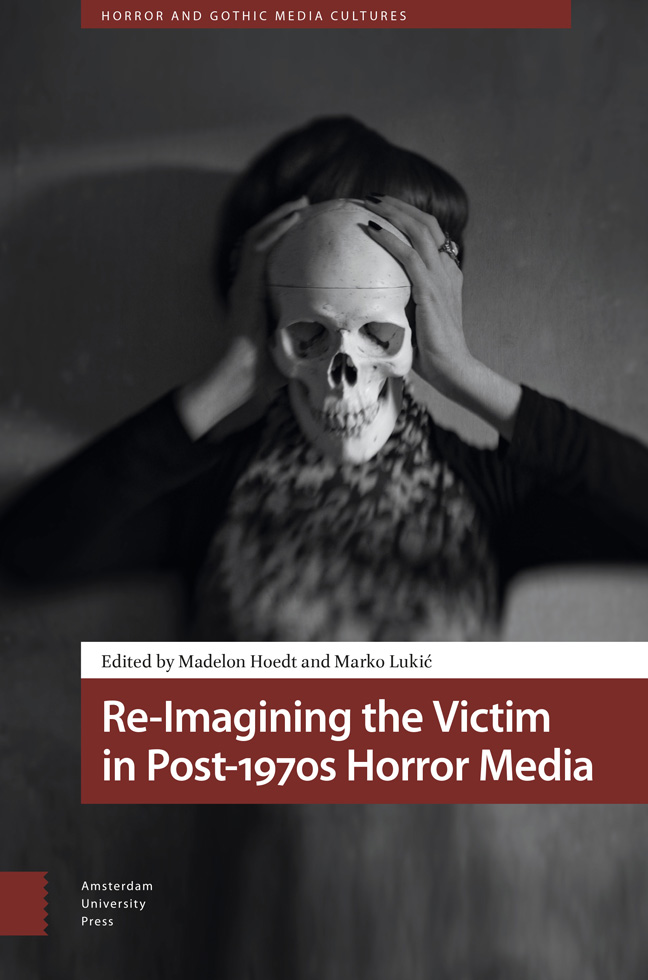Book contents
- Frontmatter
- Contents
- Introduction: Theorising the Victim
- 1 Opening the Gate: Reconfiguring the Child Victim in Stranger Things
- 2 Black Death: Black Victims in 1980s Teen Slashers
- 3 Beyond Binaries: The Position of the Transgender Victim in Horror Narratives
- 4 Through the Looking-Glass: The Gothic Victim in Jordan Peele’s Us
- 5 Postmortem Victimhood: Necrovalue in Phantasm and Dead and Buried
- 6 The Sad Killer: Perpetuating Spaces, Trauma and Violencewithin the Slasher Genre
- 7 “If this is the last thing you see… that means I died”: A Taxonomy of Camera-Operating Victims in Found Footage Horror Films
- 8 Victimhood and Rhetorical Dialectics within Clive Barker’s Faustian Fiction
- 9 Pain Index, Plain Suffering and Blood Measure: A Victimology of Driving Safety Films, 1955–1975
- 10 Biolithic Horror: Stone Victim/Victimisers in Resident Evil Village
- 11 The Potential Victim: Horror Role-Playing Games and the Cruelty of Things
- Bibliography
- Filmography
- Index
2 - Black Death: Black Victims in 1980s Teen Slashers
Published online by Cambridge University Press: 26 March 2024
- Frontmatter
- Contents
- Introduction: Theorising the Victim
- 1 Opening the Gate: Reconfiguring the Child Victim in Stranger Things
- 2 Black Death: Black Victims in 1980s Teen Slashers
- 3 Beyond Binaries: The Position of the Transgender Victim in Horror Narratives
- 4 Through the Looking-Glass: The Gothic Victim in Jordan Peele’s Us
- 5 Postmortem Victimhood: Necrovalue in Phantasm and Dead and Buried
- 6 The Sad Killer: Perpetuating Spaces, Trauma and Violencewithin the Slasher Genre
- 7 “If this is the last thing you see… that means I died”: A Taxonomy of Camera-Operating Victims in Found Footage Horror Films
- 8 Victimhood and Rhetorical Dialectics within Clive Barker’s Faustian Fiction
- 9 Pain Index, Plain Suffering and Blood Measure: A Victimology of Driving Safety Films, 1955–1975
- 10 Biolithic Horror: Stone Victim/Victimisers in Resident Evil Village
- 11 The Potential Victim: Horror Role-Playing Games and the Cruelty of Things
- Bibliography
- Filmography
- Index
Summary
Abstract
One of slasher cinema’s most notorious, but underexamined, tropes is the notion that Black characters die first. A sample of slasher films from the 1980s suggests the assertion is false, but this does not absolve such films of problematic racial constructions. Qualitative analysis shows Black victims and survivors of slashers play into anti-Black stereotypes. Most problematic here is that anti-Black stereotypes can be seen as part of the justification for the character’s slaying, thereby reflecting a broader social pattern of vilifying and minimising the suffering of Black victims. The findings of the chapter are important insofar as cinematic content trends correspond to contemporaneous sociocultural shifts and cinematic images have the power to shape the minds, conceptions and opinions of viewers.
Keywords: survivors, cinematic tropes, horror, race, racism, stereotypes
Although slasher cinema is one of the most academically scrutinised subgenres of horror (Hart 43), one of its most notorious tropes, that Black characters die first, remains underexamined. Along these lines, the chapter on 1980s horror films in Robin R. Means Coleman’s Horror Noire: Blacks in American Horror Films from the 1890s to Present is titled “We Always Die First” but offers no examples of Black characters dying first. Instead, she duly notes the deployment of the magic negro trope in The Shining (Kubrick, 1980), the continued stereotyping of Vodou in The Serpent and the Rainbow (Craven, 1988) and Grace Jones’s appearance in Vamp (Elias, 1986) as one of the few horror films to star an African American woman (145, 151–52, 155–56, 165–66). Her brief discussion of slasher cinema notes the subgenre was “extraordinarily grisly” and “very White”, leaving the trope that inspired the title of the chapter unexplored (158). Later, in the 2019 documentary Horror Noire: A History of Black Horror, Coleman clarified the Black-characters-diefirst trope, suggesting that it is not entirely true. Instead, Black characters, particularly Black males, can demonstrate the formability of the villain by serving as victims (Burgin). Do these observations pass empirical scrutiny? Prevailing literature gives no clear answer.
Several authors make glancing reference to the Black-characters-die-first trope. Here, in line with Coleman’s “very White” assessment, Isabel Cristina Pinedo argues teen slashers exclude “racial minorities altogether or relegates them to the status of victims, largely undeveloped expendable characters” (111).
- Type
- Chapter
- Information
- Re-Imagining the Victim in Post-1970s Horror Media , pp. 39 - 60Publisher: Amsterdam University PressPrint publication year: 2024



